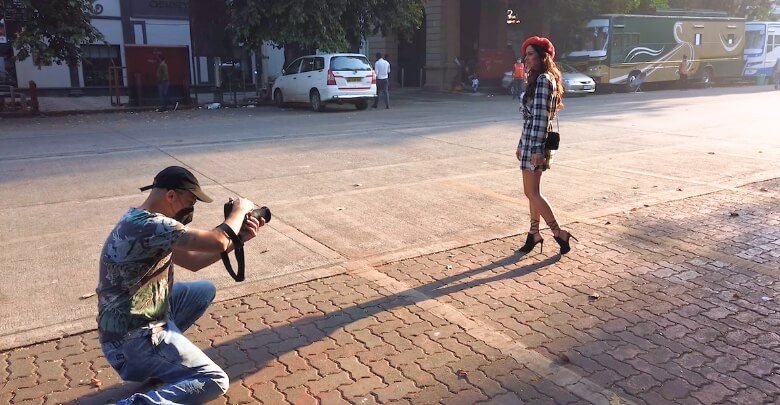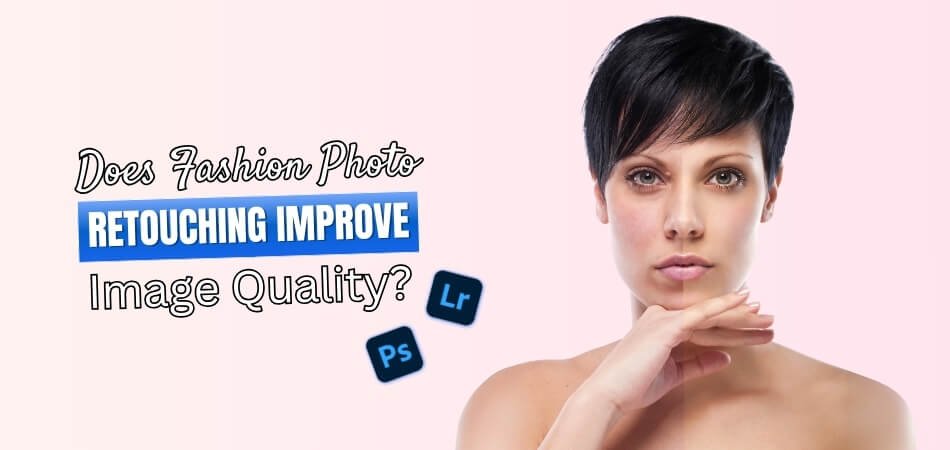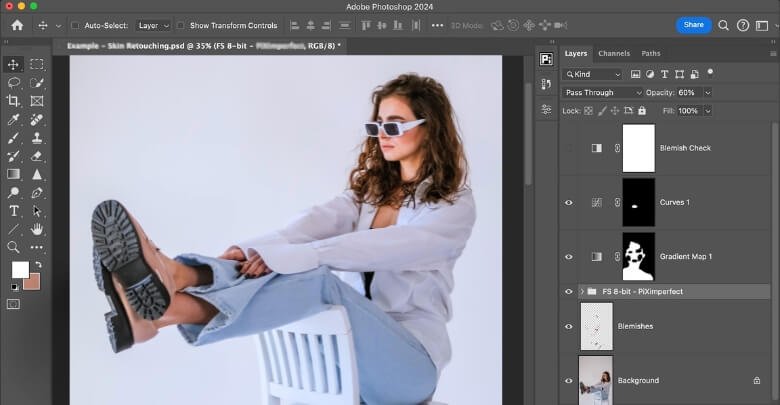Fashion photography plays a momentous role in capturing and presenting intricate details of clothing and accessories. It offers a visual feast that defines style trends and aesthetics. With its roots stretching back to photography’s early days, photo retouching has evolved significantly in the digital age.
It has become an essential tool in refining these images. Marketing, branding, and creating compelling visual stories in the highly competitive fashion industry require excellent images. That leads us to the question, does fashion photo retouching improve image quality?
Indeed, it does. By enhancing the visual appeal, refining details, and correcting imperfections, meticulous editing allows photographers and retouchers to present a polished, professional look. Nevertheless, the level of improvement varies depending on the retoucher’s skills and the project’s goals.
Dive deeper into the nuances of fashion photo retouching as we explore its impact on image quality in the following sections.
Fashion Photography: What Are the Basics?
Fashion photography is an exciting field that captures the essence of clothing and accessories at a level that appeals to designers and consumers alike. At its core, this genre involves several key elements.

Lighting plays a major role in determining the texture, mood, and overall atmosphere of the shot. The choice of background can upgrade the subject or distract from it, so selecting the right backdrop is essential. The composition and the model’s pose also contribute significantly to the image’s impact, requiring a keen eye for detail and balance.
Post-production is where fashion photos come to life. Engaging with trusted fashion photo editing services can upgrade your work, ensuring every detail from the shimmer of a necklace to the sparkle of a ring is perfectly highlighted.
For anyone keen to venture into fashion photography, mastering these basics is the first step towards mastering the art. Creating high-quality images that engage your audience is the first step.
Does Fashion Photo Retouching Improve Image Quality?
The camera captures more than just clothing in the world of fashion photography; it tells a compelling visual story. But what happens after the shutter clicks? Here lies the realm of photo retouching a process where technology meets creativity to transform acceptable photos into great ones.

The question is, does fashion photo retouching improve image quality? Absolutely, and in more ways than one. It’s not just about altering images; it’s about refining them to meet fashion industry standards. Here’s how.
Enhancing Details and Texture
Retouching allows photographers to improve garment details and textures. When working with complex patterns or delicate fabrics, subtle improvement can make a difference.
Adjusting brightness and contrast accents the texture, making the fabric seem richer and more tactile. These adjustments ensure that the clothing looks as appealing in photos as it does in real life. Marketing and sales depend on this.
Furthermore, retouching can increase the beauty of jewelry and accessories that accompany fashion pieces. By carefully refining these elements, photographers can create a cohesive look that truly pops in the final image.
Correcting Imperfections
No photo shoot is immune to imperfections, whether it’s stray hair, an unexpected shadow, or a wrinkle on the fabric. Retouching corrects these flaws. By smoothing out inconsistencies and cleaning up distractions, retouchers can achieve a cleaner and more polished look.
As a result, the focus remains on the fashion items themselves, not on any minor flaws that might distract from their beauty.
The ability to amend these aspects subtly reassures clients and designers alike that their vision will be presented in the most suitable possible light. This meticulous care in the post-production phase is what often separates professional results from amateur attempts.
Color Adjustment and Consistency
Consistency in color representation is vital in fashion photography, where accurate color portrayal can make or break a sale. Retouching helps ensure color accuracy and uniformity across a series of images.
Adjustments to saturation and hues ensure that the clothing colors are vibrant and true to life. It is especially important in online shopping, where a customer only has visual cues.
Moreover, maintaining color consistency across different outfits and accessories in a collection ensures a unified look that is aesthetically pleasing and professional. This not only elevates the visual appeal but also builds brand reliability and trust among consumers.
A fashion photo retouching service improves the quality of an image by enhancing details, correcting imperfections, and ensuring color consistency. Fashion photo retouchers can apply these changes effectively when they use specialized software for fashion photo retouching.
This enhancement process, therefore, is not just optional; it is essential for anyone looking to succeed in fashion photography competition.
How is the Fashion Photo Retouching Can Be Done?
Fashion photo retouching transforms raw images into polished masterpieces, ready for magazines and ads. This process is not just about fixing flaws; it’s about enhancing the overall quality of the image to reflect the true essence of the fashion items being showcased. Let’s dive into the typical steps involved in fashion photo retouching.

Step 1: Initial Cleanup
To begin with, the process usually involves cleaning up the image. This includes removing any unwanted elements like dust, scratches, or stray hairs that might distract from the main subject.
Retouchers carefully scrutinize the image, ensuring that the background and the model look flawless without losing scene texture or detail.
Step 2: Adjusting the Colors
Following that, color adjustment is crucial for bringing out the vibrancy and accuracy of the colors in the image. Retouchers work on saturation, contrast, and brightness to ensure the colors match what the garments look like in reality.
Maintaining consistency across a fashion line requires this step. Visual accuracy is especially significant when images are used for online shopping.
Step 3: Refining Details
Furthermore, refining details involves enhancing specific features of the image. This might include sharpening the edges of a dress, highlighting the texture of fabrics, or even subtly altering the lighting effects to better showcase the clothing.
Due to this meticulous attention to detail, the final image depicts the clothes most realistically and attractively possible.
Pros and Cons of Fashion Photo Retouching
Fashion photo retouching is often seen as a magic wand that transforms ordinary images into spectacular ones. In fashion, this is of utmost importance. While it’s celebrated for its ability to perfect and polish, retouching also comes with its share of drawbacks.
Let’s explore the pros and cons of fashion photo retouching to understand this practice better.
Pros:
- Amplifies visual appeal: Makes images more attractive and eye-catching.
- Corrects imperfections: Smooths out flaws, ensuring models and garments look their most attractive.
- Adjusts colors accurately: Ensures true colors are represented, crucial for online sales.
- Highlights details: Brings out textures and details in fabrics that might be missed in raw photos.
- Creates consistency: Maintains a uniform look across all images in a collection or campaign.
- Saves costs: Less expensive than reshooting if the issues are minor.
- Boosts sales: Attractive images can increase consumer interest and drive sales.
Cons:
- Can be misleading: Over-editing may misrepresent the product, leading to customer dissatisfaction.
- Time-consuming: Extensive editing can delay marketing.
- Requires skill: High-quality retouching needs professional skills, which can be costly.
- Promotes unrealistic standards: This can contribute to unrealistic beauty standards in fashion advertising.
- Dependency: Over-reliance on retouching might reduce initial photography quality.
Fashion photographers can make informed decisions about retouching by knowing these pros and cons.
FAQs About Does Fashion Photo Retouching Improve Image Quality?
An appreciation and expertise in fashion photography can be greatly strengthened by being aware of the various types and nuances. Here are some frequently asked questions that shed light on key aspects of this field.
What Are the 4 Different Types of Fashion Photography?
Fashion photography is diverse and can be categorized into four main types: high fashion, editorial, street fashion, and catalog photography. Each type has its own style and focus, catering to different aspects of the fashion industry.
What is High-End Fashion Photography?
High-end fashion photography represents the pinnacle of fashion imagery, often featuring luxurious brands and top-tier models. It requires creativity, meticulous planning, and a deep understanding of fashion. The images capture the luxurious essence of the brands.
What is a Luxury Brand Image?
Luxury brand image is cultivated through exclusivity, superior quality, and high prices. These elements combine to create a prestigious perception that attracts a specific audience who values these characteristics in their purchases.
Does Retouching Affect Fashion Photography Authenticity?
While retouching improves visual appeal, it sometimes compromises photographs’ authenticity. To preserve the true essence of the items photographed, it’s important to find a balance.
Can Retouching Influence Consumer Expectations?
Yes, retouching sets high consumer expectations. When images are heavily edited, they can portray an idealized version of products that may not align perfectly with the actual items. Customers may become dissatisfied as a result.
What Are the Ethical Considerations in Fashion Photo Retouching?
Ethical considerations in retouching involve transparency about the extent of editing. Further, they involve avoiding alterations that may mislead consumers or perpetuate unrealistic beauty and style standards.
Does the Retoucher’s Skill Level Impact the Final Image Quality?
The retoucher’s skill level plays a critical role in the final image quality. Experienced retouchers can improve images subtly and effectively, while less skilled practitioners might produce unnatural or overmodified results.
How Does Retouching Contribute to Fashion Brand Identity?
Retouching helps craft a consistent brand identity by ensuring that all images reflect the brand’s aesthetic and quality standards consistently. A strong brand image is essential for marketing.
Bottom Lines
Fashion photo retouching has proven to be a valuable tool for improving the quality of images. This process corrects imperfections and heighten details but also ensures color accuracy and consistency across photos.
Consequently, does fashion photo retouching improve image quality? It does, by bringing a professional and polished look to every shot. For those looking to refine their retouching process, investing in skilled professionals and high-quality software is key.
It’s also crucial to maintain a balance, ensuring images remain true to the original while showcasing their most appealing aspects. These tips can help optimize the retouching process, enhancing both image quality and viewer experience.